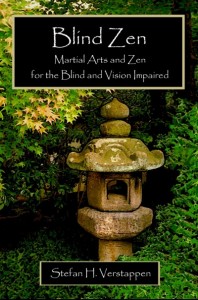Martial Arts and Zen for the Blind and Vision Impaired
Is it possible for a blind person to follow the Way of the Warrior?
Blind Zen tells the story of how a blind woman’s efforts to learn self defense led to a unique experiment to adapt martial arts and eastern philosophy to develop new skills and increase self confidence.
This book includes descriptions and scientific explanations of the unique Zen inspired exercises that anyone can learn and provides a fresh new approach and exciting possibilities to improve the quality of life of the vision impaired.
Also available as Audio Book. Click here for more info.
This manual provides 23 practical easy-to-learn exercises that teach how to:
Improve your sense of balance Improve your sense of proprioception
Refine the sense of hearing and create an auditory map of your surroundings
Train the sense of smell to gather information from your environment
Overcome the numerous fears associated with blindness
Become more aware of the unconscious sensory information known as synesthesia
13 Practical self defense techniques anyone can learn.
Reviews
“I enjoyed reading your book. The philosophy behind Zen training for the
visually impaired is fascinating and was quite helpful to me.
“Eye-opening” if you will. Being in-tune to all one’s senses is an excellent lesson
in patience and understanding of human emotions.”Jenny Grill
Minnesota Radio Talking Book Network
“Do you know how relevant much of what you have written is for those teaching visually impaired and blind individuals, especially Orientation and Mobility Instructors? The chapters on posture, training exercises for posture, physical fitness, balance, training methods for balance, sensory enhancement training, perception, hearing, olfaction, walking lessons, breathing, muscle relaxation, fear, and touch sensitivity are all key components of our educational and practical training. What a journey for both you and Susan!”
This is an important book.
Tom Attebery
Orientation & Mobility Specialist
Halifax, Nova Scotia
“Thank you so much for sending me your informative manuscript. I found it to be a good read and your innovative approach to teaching Susan was excellent. You have done a pretty fine job!”
Ms Kathy Fela
Client Liaison Unit
Royal Blind Society
Sydney, Australia
“Your manuscript was a delight to read. It is well written, and I liked your inclusion of Zen wisdom, and teachings.”
You give a very order cialis over internet thorough account of the technicalities of using the other senses in the absence of sight.”
Rowena Jitts BCA
Sydney, Australia
“So far I think it is very good. In the introduction you make me feel like you know what you’re talking about and that you have looked into the subject of the blind warriors. The Zen quotes were good. You make it sound like it is really possible for a blind reader to improve their abilities and that is excellent.
I also admire your keen interests and efforts to see if a blind person can truly become a good martial artist. You have taken real steps towards showing (what a lot of people think as silly and impossible) that a blind person can become not simply a competent fighter, but also a more secure, better grounded, and wholly confident person who feels they truly do have a place in this world.
Thank you again for this opportunity to be one of the first to read, what is in my opinion, the beginning of a whole new lease on life for visually impaired people everywhere. ”
Jamie Marshall
Visually Impaired Student
Edinburgh Scotland
Table Of Contents
Introduction
Grounding
Posture
Training Exercises for Posture
General Principles of Good Posture
Holding the Jug
Horse Stance Training
Tai Chi Walking
The Stop Exercise
Balance
How We Sense Balance
Training Methods for Balance
Three Point Balance
Walking the Curb
Sensory Enhancement Training
Perception
Hearing
What the Ears Sense
Training Methods: Hearing
Auditory Indexing: (Trainer)
Audio Calibration
Extending Hearing Exercise
Care for the Ears
Olfaction
How the Nose Senses
What the Nose Senses
Training Methods: The Nose
The Technique of Sniffing
Tracking
Walking Lessons
The Seventh Sense
No Mind
The Hidden Sense
Training the Seventh Sense
Quiet & Isolation
Inner Calm
Detachment
Fear
The Physiological Basis of Fear
Training Methods to Control Fear
Breathing
Calming Breath
Abdominal or Deep Breathing
Rhythmic Breathing
Bamboo Breathing
Relaxation
Controlling Tension
Classical Conditioning
Releasing the Bowstring
Systematic Muscle Relaxation
Systematic De-sensitization
Walking Lesson
Self Defense
Touch Sensitivity
Touch Sensitivity Exercise
Self Defense Techniques
Defense Against Front Hand Grab
Defense Against Double Hand Grab From Behind
Defense Against Front Hand Choke
Escape against Hand Choke from Behind
Escape from Choke from Behind [Arm Bar]
Defense against Wristlock or Hammerlock
Bear Hug from Behind [Under arms]
Escape from Bear Hug from Behind [Over Arms]
Defense Against Front Bear Hug [Under arms]
Front Bear Hug [Over arms]
Hair Grab from Behind
Escape from Side Head Lock
Advanced Martial Arts
Forms/ Katas
Sparring
Weapons
Conclusion
Post Script
Appendix A Physical Fitness Training
Glossary of Martial Arts Styles
Bibliography
End Notes
